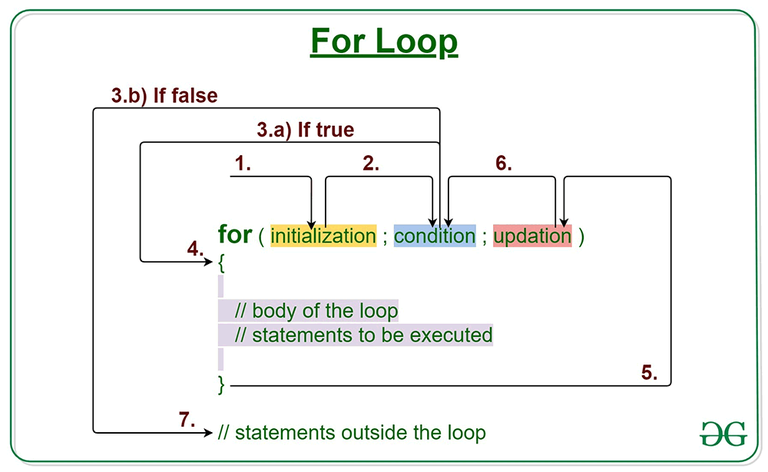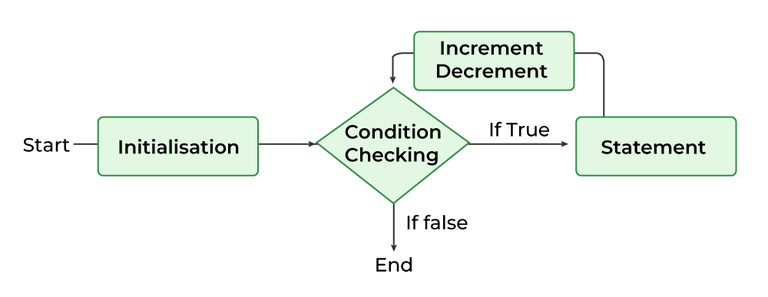Java For Loop (original) (raw)
Last Updated : 17 Apr, 2025
**Java for loop is a control flow statement that allows code to be executed repeatedly based on a given condition. The **for loop in Java provides an efficient way to iterate over a range of values, execute code multiple times, or traverse arrays and collections.
Now let's go through a simple **Java for loop example to get the clarity first.
**Example:
Java `
// Java Program to demonstrate for loop class Geeks {
public static void main(String args[]) {
// for loop to print numbers from 1 to 5
for (int i = 1; i <= 5; i++) {
System.out.println("" + i);
}
System.out.println("Loop has ended.");
}}
`
Output
1 2 3 4 5 Loop has ended.
**Dry-Running Above Example
- The program starts.
- The for loop initializes i to 1.
- Condition i <= 5 is checked.
- If true:
* Statement inside the loop executes, printing the current value of i.
* Increment i by 1. - If false:
* Loop terminates, and the program continues.
- If true:
- Steps repeat until i becomes 6, at which point the condition fails, and "Loop has ended." is printed.

For Loop in Java
**Syntax
for (initialization expr; test expr; update expr)
{
// body of the loop
// statements we want to execute
}
Working
- Control enters the **for loop.
- **Initialization is executed once at the beginning of the loop.
- The Condition is evaluated:
- If true, the control moves to Step 4.
- If false, the control jumps to Step 7.
- The body of the loop is executed.
- Control moves to the **Updation step.
- After **Updation, the flow returns to the Condition (Step 3) and repeats the process.
- Once the condition becomes false, the control exits the for loop, and statements outside the loop are executed.
**Java for loop is divided into various parts as mentioned below:
- Initialization Expression
- Test Expression
- Update Expression
1. **Initialization Expression
Initializes the loop variable. This is executed once at the start of the loop.
**Example:
int i = 1;
2. **Test Expression
Tests the loop condition. If true, the loop body is executed; otherwise, the loop terminates.
**Example:
i <= 10
3. **Update Expression
After executing the loop body, this expression increments/decrements the loop variable by some value.
**Example:
i++;
**Flow Chart for loop in Java

**Example 1: Printing Numbers from 1 to 10
Java `
// Java program to print numbers from 1 to 10 class Geeks { public static void main(String[] args) { for (int i = 1; i <= 10; i++) { System.out.println(i); } } }
`
Output
1 2 3 4 5 6 7 8 9 10
**Example 2: Printing "Hello World" 5 Times
Java `
// Java program to illustrate for loop class Geeks { public static void main(String args[]) {
// Writing a for loop
// to print Hello World 5 times
for (int i = 1; i <= 5; i++)
System.out.println("Hello World");
}}
`
Output
Hello World Hello World Hello World Hello World Hello World
**Example 3: Calculating Sum from 1 to 20
Java `
// Java program to calculate the // sum of numbers from 1 to 20 class Geeks { public static void main(String args[]) { int s = 0;
// for loop begins
// and runs till x <= 20
for (int x = 1; x <= 20; x++) {
s = s + x;
}
System.out.println("Sum: " + s);
}}
`
Nested For Loop
**Java Nested For Loop is a concept of using a for loop inside another for loop. It is commonly used for multidimensional problems.
**Example: Printing a Matrix-like Pattern
Java `
// Java program to illustrate // Nested For Loop class Geeks {
public static void main(String[] args) {
for (int i = 1; i <= 3; i++) {
for (int j = 1; j <= 3; j++) {
System.out.print("(" + i + "," + j + ") ");
}
System.out.println();
}
}}
`
Output
(1,1) (1,2) (1,3) (2,1) (2,2) (2,3) (3,1) (3,2) (3,3)
**Note: To know more about Nested loops refer Nested loops in Java.
Java Infinite for Loop
An **infinite loop occurs when the loop's condition never becomes false. In the example below, the condition **i >= 1**always evaluates to true, leading to an infinite loop.
**Example 1:
Java `
// Java Program to Illustrate // infinite loop class Geeks { public static void main(String args[]) { for (int i = 1; i >= 1; i++) { System.out.println("Infinite Loop " + i); } } }
`
**Output:
Infinite Loop 1
Infinite Loop 2
...
**Example 2: Another way to create an infinite loop is by using empty semicolons ****;;** in the for loop.
Java `
public class Geeks { public static void main(String[] args) {
for (;;) {
System.out.println("Infinite Loop");
}
}}
`
**Output:
infinite loop
infinite loop
....
**Important Note: A "Time Limit Exceeded" error occurs when a program runs longer than the time allocated for execution, due to infinite loops.
Advantages of for Loop
- This is ideal for iterating over a known range or collection.
- Efficient syntax for initialization, condition checking, and incrementing.
- Easy to control the number of iterations.
- Efficient for looping through arrays and collections.